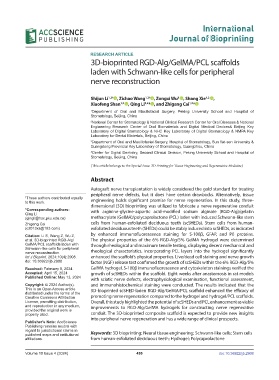Page 467 - IJB-10-4
P. 467
International
Journal of Bioprinting
RESEARCH ARTICLE
3D-bioprinted RGD-Alg/GelMA/PCL scaffolds
laden with Schwann-like cells for peripheral
nerve reconstruction
Shijun Li 1,2† id , Zichao Wang 1,2† id , Zongxi Wu id , Shang Xie 1,2 id ,
3
Xiaofeng Shan 1,2 id , Qing Li * id , and Zhigang Cai * id
2,4
1,2
1 Department of Oral and Maxillofacial Surgery, Peking University School and Hospital of
Stomatology, Beijing, China
2 National Center for Stomatology & National Clinical Research Center for Oral Diseases & National
Engineering Research Center of Oral Biomaterials and Digital Medical Devices& Beijing Key
Laboratory of Digital Stomatology & NHC Key Laboratory of Digital Stomatology & NMPA Key
Laboratory for Dental Materials, Beijing, China
3 Department of Oral and Maxillofacial Surgery, Hospital of Stomatology, Sun Yat-sen University &
Guangdong Provincial Key Laboratory of Stomatology, Guangzhou, China
4 Center for Digital Dentistry, Second Clinical Division, Peking University School and Hospital of
Stomatology, Beijing, China
(This article belongs to the Special Issue: 3D Printing for Tissue Engineering and Regenerative Medicine)
Abstract
Autograft nerve transplantation is widely considered the gold standard for treating
peripheral nerve defects, but it does have certain drawbacks. Alternatively, tissue
† These authors contributed equally
to this work. engineering holds significant promise for nerve regeneration. In this study, three-
dimensional (3D) bioprinting was utilized to fabricate a nerve regenerative conduit
*Corresponding authors: with arginine-glycine-aspartic acid-modified sodium alginate (RGD-Alg)/gelatin
Qing Li
(qingli@hsc.pku.edu.cn) methacrylate (GelMA)/polycaprolactone (PCL) laden with induced Schwann-like stem
Zhigang Cai cells from human-exfoliated deciduous teeth (scSHEDs). Stem cells from human-
(c2013xs@163.com) exfoliated deciduous teeth (SHEDs) could be stably induced into scSHEDs, as indicated
Citation: Li S, Wang Z, Wu Z, by enhanced immunofluorescence staining for S-100β, GFAP, and P0 proteins.
et al. 3D-bioprinted RGD-Alg/ The physical properties of the 6% RGD-Alg/5% GelMA hydrogel were determined
GelMA/PCL scaffolds laden with through rheological and maximum tensile testing, displaying decent mechanical and
Schwann-like cells for peripheral
nerve reconstruction. rheological characteristics. Incorporating PCL layers into the hydrogel significantly
Int J Bioprint. 2024;10(4):2908. enhanced the scaffold’s physical properties. Live/dead cell staining and nerve growth
doi: 10.36922/ijb.2908 factor (NGF) release test confirmed the growth of scSHEDs within the 6% RGD-Alg/5%
Received: February 8, 2024 GelMA hydrogel. S-100β immunofluorescence and cytoskeleton stainings verified the
Accepted: April 15, 2024 growth of scSHEDs within the scaffold. Eight weeks after anastomosis in rat models
Published Online: May 13, 2024 with sciatic nerve defects, electrophysiological examination, functional assessment,
Copyright: © 2024 Author(s). and immunohistochemical staining were conducted. The results indicated that the
This is an Open Access article 3D-bioprinted scSHED-laden RGD-Alg/GelMA/PCL scaffold enhanced the efficacy of
distributed under the terms of the
Creative Commons Attribution promoting nerve regeneration compared to the hydrogel and hydrogel/PCL scaffolds.
License, permitting distribution, Overall, this study highlighted the potential of scSHEDs and PCL enhancement as viable
and reproduction in any medium, improvements to RGD-Alg/GelMA hydrogels for constructing nerve regenerative
provided the original work is
properly cited. conduit. The 3D-bioprinted composite scaffold is expected to provide new insights
into peripheral nerve regeneration and has a wide range of clinical prospects.
Publisher’s Note: AccScience
Publishing remains neutral with
regard to jurisdictional claims in
published maps and institutional Keywords: 3D bioprinting; Neural tissue engineering; Schwann-like cells; Stem cells
affiliations. from human-exfoliated deciduous teeth; Hydrogel; Polycaprolactone
Volume 10 Issue 4 (2024) 459 doi: 10.36922/ijb.2908

